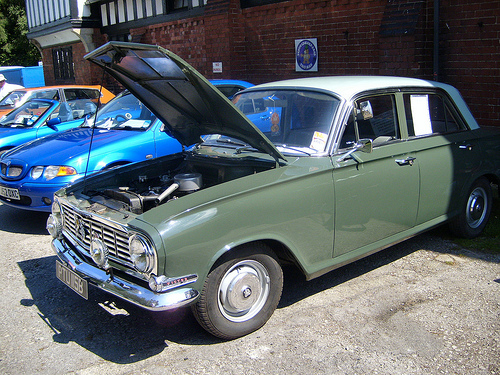
The Vauxhall Victor FB Series UK 1964.
| November 13, 2018The Vauxhall Victor FB Series UK 1964.

Image by ronsaunders47
The Vauxhall Victor is a large family car which was produced by Vauxhall Motors, the British subsidiary of General Motors, from 1957 to 1976. The Victor was introduced to replace the outgoing Wyvern model. It was later renamed the VX Series and continued until 1978, by which time it had grown significantly and was viewed, at least in its home market, as a larger-than-average family car.
The Victor was replaced by the Carlton, which was based on the German Opel Rekord D. The last model, the Victor FE, was also manufactured under licence by Hindustan Motors in India as the Hindustan Contessa, during the 1980s and early 1990s, with an Isuzu engine.
The original Victor became Britain’s most exported car,[citation needed] with sales in markets as far flung as the United States (sold by Pontiac dealers, as Vauxhall had been part of GM since 1925), Canada, Australia, New Zealand, South Africa and Asian right hand drive markets such as Ceylon (now Sri Lanka), India, Pakistan, Malaysia, Thailand and Singapore.
In Canada, it was marketed as both the Vauxhall Victor (sold through Pontiac/Buick dealerships) and the Envoy (marketed through Chevrolet/Oldsmobile dealers). The Victor was also instrumental in giving Vauxhall its first in-house-designed estate car, which complemented the four-door saloon.
The cleaner styled FB ran from 1961 until 1964. It was widely exported, though sales in the US ended after 1961 when Pontiac, Oldsmobile and Buick came up with home-grown compact models of their own. Consequently, the FB only achieved sales of 328,000 vehicles by the time it was replaced in 1964. The body styling owed nothing to any US GM influence, the flat front and turtle-deck rear resembling some older US Fords. Mechanically, the main change was the option of a 4-speed all-synchromesh transmission with floor change but the previously used 3-speed column change unit was still fitted as standard. The engine was also revised with higher compression ratio and revised manifolding increasing the power output to 49.5 bhp (37 kW; 50 PS). In September 1963 the engine was enlarged from 1508 to 1594 cc.[8] The increased capacity coincided with a further increase in the compression ration of the standard engine from 8.1:1 to 8.5:1, reflecting the continuing increase the average octane level of "premium grade" fuel (on which the Victor unit had by now standardised) offered in the UK, now to 97 (RON).[6] 1963 was also the year when front disc brakes with larger 14 in (360 mm) wheels became an option. Models with the larger engine had a revised frontal treatment with a block style grille element and revised parking lights at either lower extreme of the grille.
A Vynide-covered bench front seat was standard on the base model and Super Victor but individual seats were standard on the De Luxe and optional on the lower priced cars. Other options included a heater, fog lamps, radio, screen washers, reversing light and seat belts.
The FB was the first Victor to spawn a sporty VX4/90 derivative
A 1508 cc "Super" version was tested by the British magazine The Motor in 1961 and was found to have a top speed of 76.2 mph (122.6 km/h) and could accelerate from 0-60 mph (97 km/h) in 22.6 seconds. A fuel consumption of 32.2 miles per imperial gallon (8.77 L/100 km; 26.8 mpg-US) was recorded. The test car cost £798 including taxes of £251.[7]
A sporty derivative, the VX4/90, was also available, with twin-carburettor, high-compression, engine giving 71 bhp (53 kW; 72 PS) and servo-assisted brakes. Externally the car was distinguished from the standard car by a coloured stripe down the side, revised grille and larger tail-light clusters. These cosmetic features were essentially similar to the Canadian-market-only Envoy models.
The VX4/90 was available only in saloon form.
General Motors New Zealand assembled the Victor FB sedan line in New Zealand, in Super form with column shift manual. Wagons, Deluxe sedans and the VX4/90 were rare imports, many under the no-remittance, no overseas exchange, deposit scheme available to consumers at the time. The Kiwi models were facelifted for 1964 but did not get the revised rear licence plate surround introduced in the UK market.

